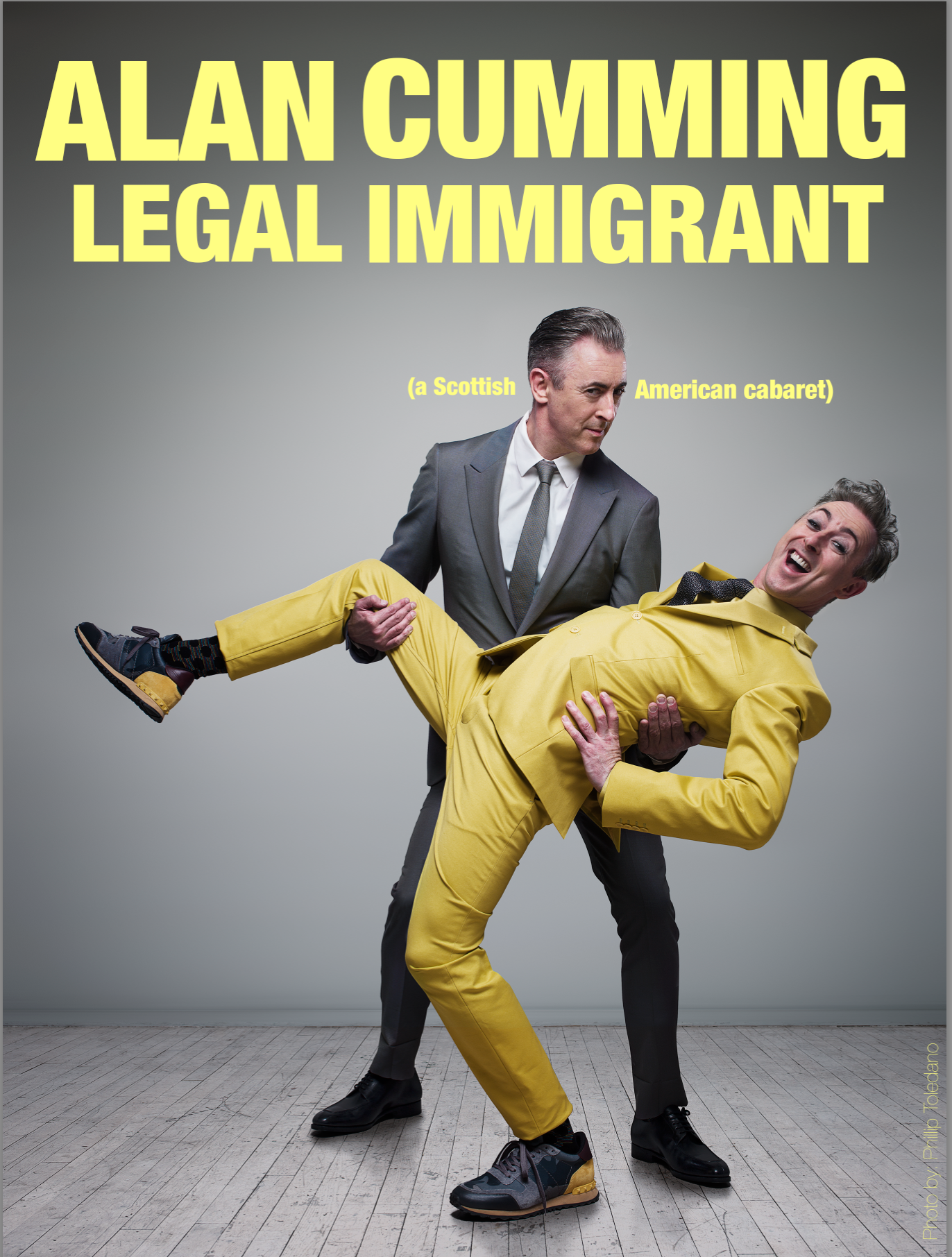I wrote this article about my dear chum Monica Lewinsky for Variety when she was included in their New Power of New York list.
Legal Immigrant











I began touring a new cabaret show, Legal Immigrant, at the Benaroya Hall in Seattle on Thursday May 3rd. I was with my usual musical compatriots - MD Lance Horne, Eleanor Norton on cello and Chris Jago on drums and guitar, and also joined by Riley Mulherkar on trumpet.
The show was inspired by a few things: my ten year anniversary of becoming a US citizen; the negative rhetoric around the whole subject of immigration, legal or not, being propagated by the Trump administration; and the recent removal of the phrase 'nation of immigrants' from the United States Citizenship and Immigrations Services website. History is being rewritten before our very eyes, and a country so rich in diversity because of the immigrants who have come to live here and pursue whatever the American dream means to them is in denial and claiming that it is no longer diverse. My show is a celebration of immigration, and my feelings on growing older and being an American citizen in the time of Donald Trump.
After opening in Seattle we toured to Denver, Salina, Kansas City, Toronto, NYC (where we played two weeks of shows at the legendary Cafe Carlyle and then midnight shows downtown at Joe's Pub), Westhampton, San Francisco, Chicago, Great Barrington, Washington DC, Boston, New Brunswick, West Palm Beach, Scottsdale and Tucson.
Finally, one night during our mad NYC run we decided to take the subway downtown from the Cafe Carlyle to Joe’s Pub, and we decided we’d have a go at busking! We also happened to have a film crew in tow. So I sang Caledonia on the 6 train!
NY Times Book Review
I reviewed David Sedaris' Calypso for the New York Times Book review. Here's what I had to say...
Straight away, I think it is in the common interests of transparency and full disclosure to tell you that over the last few weeks since I — and I fear this is no coincidence! — began reading the book that is the subject of this review, there has been a gradual, yet very distinct, change in my outlook, demeanor and even my worldview. My life has assumed an overreaching hue that can be described only, and I do mean be described only as, well, Sedarian.
It first came to my attention in the Aspire Lounge of the Edinburgh airport, which, I assume, is so named because there is a relatively short window between when you have entered it and when you aspire to leave.
“Porridge is available on request” declared a sign next to the sausages. My US/UK power adapter was one of those annoying ones that have a protruding ridge, so the only way my computer charger would remain in the socket was to wedge my copy of “Calypso” between my chair and said socket, ensuring my laptop didn’t die but forcing me to restrict my movements to all but the most legato typing.
My husband had fallen asleep next to me, and I worried that if his head lolled even a few centimeters he might scupper the entire perilous system — yet waking him to warn him might result in the exact same outcome.
What would David Sedaris do? I thought to myself.
I was trapped, I realized, on the inside of a mask once worn by the man himself. I felt his potency. It was palpable. He seriously could start a cult. It would be a total hoot. Not for everyone, true — but I’m in.
It’s not like there weren’t warning signs: That morning as I drove to the airport I listened to BBC Radio Scotland and nearly drove off the road laughing at a new campaign to encourage people to learn CPR by using the Proclaimers song “I’m Gonna Be (500 Miles).” “And I will press 500 times, And I will press 500 more, Just to be the one to save you, Till the ambulance comes to your door,” declared Carol Smillie, a TV host long beloved by my people.
It seemed that this entrancing collection of essays, and my fascination with its author, had sucked me into some nerdy netherworld where real life becomes weirder and funnier and darker and bleaker than, well, real life.
I have come to the conclusion that David Sedaris is not just some geeky Samuel Pepys, as I had assumed all these years. True, he may shed a revelatory light on the more extreme facets of our societal spectrum through his bizarre and pithy prism. Yes, his worldview — a fascinating hybrid of the curious, cranky and kooky — does indeed hold a mirror up to nature and shows us as others see us. But make no mistake: He is not the Fool, he is Lear.
West Sussex in England and Emerald Isle in North Carolina are his kingdoms. Amy, Gretchen, Lisa, Paul and the tragic Tiffany are his royal siblings, ever shifting in their allegiances and presence in each other’s lives. Lou is his father, once so distant and scornful of his fragile son, now softer and benign, proffering unwanted gifts that Sedaris has learned are easier for all concerned to accept with grace.
The family home in Raleigh was once presided over with gusto by Sharon, the Sedaris matriarch. Her death from cancer hangs over these pages like a long-ago exhaled puff of a Winston. Like the plot of nearly every decent Disney movie, the young Sedaris princes and princesses were sent out into the scary grown-up world motherless and rudderless but buoyed by her magnificent spirit.
Sharon had developed slowly into a messy alcoholic. It took her kids many years to realize this about the woman they all adored, who nightly would clutch the kitchen counter to steady herself as she launched into one of her hilarious and biting rants. I got them laughing was both her mantra and catchphrase, yet none of those truly loving children could ever bring themselves to challenge her about it, let alone help her. And, alas, their silence did not protect her.
This failure, this regret and, actually, this neglect is haunting to the point of being unbearable, yet Sedaris’s brash and raw eloquence allows us to never linger too long in the darkness. He doesn’t just bring gallows humor, he brings gallows rimshot.
This book allows us to observe not just the nimble-mouthed elf of his previous work, but a man in his seventh decade expunging his darker secrets and contemplating mortality. “Calypso” chronicles his latest attempts to come to terms with the slings and arrows of truly outrageous fortune that life has flung at him.
For Lear the storm is the central metaphor: the elemental storm, the societal storm he has engendered and the internal storm as he struggles with pride, age and looming madness. For Sedaris a snapping turtle with a partly missing foot and a tumor on its head becomes an unlikely leitmotif. He encounters the turtle in a canal on Emerald Isle, and a semiotic friendship begins. Well, perhaps not a friendship, but certainly a one-sided appreciation. Not only does the author visit the turtle to feed it scraps like some novice apostle leaving sacrifices for his deity, but when he himself finds a tumor on his tummy, one of the harmless fatty ones that nonetheless grow to the size and consistency of a hard-boiled egg, he decides to have it removed and take it back to the island to feed it to his turtle friend — both the ultimate act of devotion and the creation of a new literary genre: tumor humor.
Initially at least, these plans are foiled by his surgeon. “It’s against federal law for me to give you anything I’ve removed from your body,” he tells the author, who promptly flees the scene, tumor intact. A less staunch man might have abandoned his plan there and then, but Sedaris perseveres and eventually finds a lovely Mexican lesbian who offers to perform the surgical deed after he tells the story of his first, failed attempt to feed the turtle his lump during a book reading in El Paso. The woman — her pseudonym is Ada — sends the tumor to his sister Lisa, who keeps it in her freezer until the next time the Sedaris clan gathers at Emerald Isle.
The brilliance of David Sedaris’s writing is that his very essence, his aura, seeps through the pages of his books like an intoxicating cloud, mesmerizing us so that his logic becomes ours: I found myself rooting for him to be able to keep his tumor and longing for the beautiful, climactic reunion scene when the sick turtle eats it.
And it soon becomes clear why Sedaris finds it so important to be the master of his tumor: He sees himself in that turtle — weird, slightly damaged, set in his ways — so feeding it a part of him is also replenishing himself. King Lear gave away his lands, David Sedaris gives away his fatty lump.
Health matters, aging and death itself are omnipresent in this book, like tentacles pulling a collection of stories together into a whole. Nowhere is the pain and mundanity of loss more hauntingly evoked than in the revelations about the suicide of the writer’s sister Tiffany. Her death is mentioned early and referred to throughout, each heartbreaking detail adding a piece to this jigsaw of suburban family pain and confusion.
Sedaris’s description of his last encounter with Tiffany — beautifully lobbed at the reader from left field — describes her waiting for him at the stage door after one of his rock-star-like literary entertainments. That evening Sedaris feels empowered enough to deny his unpredictable and flailing sibling access to him. He feels content enough to think of his own well-being above her toxic needs. He revels, for a tragic, misplaced moment, in the power of being a star, and at his behest the door closes on Tiffany’s face. They never see each other again, and she later kills herself in a manner as determined and cold as her brother’s rejection that night.
Of course such a tragedy sends reverberations throughout the family. Realignment is inexorable. He did not seek the position, and has somewhat reluctantly assumed the role, but there is no doubt that David Sedaris has become the daddy of his family. The geeks really do inherit the earth.
One day recently when walking home across town in Lower Manhattan, I bumped into Amy Sedaris, the author’s sister. We had worked together on “The Good Wife” when she came into the show to be my character’s professional rival and love interest. One scene had her squirt whipped cream on my fingers and lick it off, and she actually bit me. Quite hard. I am nuts about her.
We stopped to say hello. I noticed she had been shopping and was carrying several packages and bags. My mind flashed to the chapter in this book where she, her brother and their sister Gretchen travel to Japan to go shopping. But not just shopping. They become cave men, shopping beasts, consumer omnivores. And now here was one of them, today’s catch in hand, beaming shyly at me in the middle of Broadway. It felt like a character from a book had tumbled down from the sky into my life, and of course she had. If I now viewed my life in glorious Sedariscope, it felt completely logical that one of his sisters should be enacting a story from the book in front of me. And also logical that seconds later, mid-pleasantry, we should both realize that the lights had changed to green and we were about to be mowed down and become New York City roadkill.
Death and family are what this book is all about. Maybe what all David Sedaris’s work is about? Maybe what all good writing has to be about for they are really the only constants in all our lives? We can avoid neither and the existence of both reminds us that we are no different from one another.
As Sedaris says, “They’ve always done that for me, my family. It’s what keeps me coming back.”
Many Fathoms Deep


I returned to the Met a few nights later to perform a concert on Valentine's Day. It was called Many Fathoms Deep: A Valentine From Alan Cumming and you can watch it here
It was billed as:
Love is no ordinary emotion, and Alan Cumming is no ordinary performer. Bringing a taste of Club Cumming - his debauched and delightful East Village bar - uptown to The Met, the Tony Award-winning star hosts an evening of amour-themed song, spoken word and all else the cabaret has to offer. Cumming's musical director and longtime collaborator Lance Horne and special guests will also be on hand for this bawdy tribute to St Valentine.
My guests were Cat Cohen, Daphne Always, Meow Meow, Sienna Miller and Natalie Joy Johnson. Eleanor Norton played the cello and Carmine Covelli was on drums
